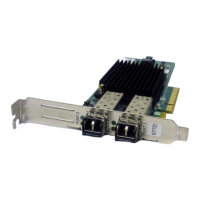• For support details, see the Linux Alert website (http://www14.software.ibm.com/webapp/set2/sas/f/
lopdiags/info/LinuxAlerts.html).
PCIe3 2-port 40 GbE NIC RoCE QSFP+ adapter (FC EC3A and FC EC3B; CCIN 57BD)
Learn about the specications and operating system requirements for the feature code (FC) EC3A and FC
EC3B adapters.
Overview
The FC EC3A and FC EC3B is a PCIe generation-3 (PCIe3), dual port, 40-Gigabit Ethernet (GbE) adapter
with a PCIe 3.0 host bus interface. The FC EC3A is a low-prole adapter and the FC EC3B is a regular
height adapter. The adapter acts as a network interface controller (NIC) and uses the IBTA RDMA over
Converged Ethernet (RoCE) protocols to provide efcient Remote Direct Memory Access (RDMA) services.
The adapter delivers high-bandwidth and low-latency 40 GbE connectivity, reducing the load on the
processor and efciently using the memory access. This action off-loads the processor from networking
tasks which improves the performance and scalability of the processor.
The adapter is optimized for enterprise data centers, high-performance computing, transaction
databases, cloud computing, virtualization, storage, and other embedded environments. The adapter
improves network performance by increasing available bandwidth to the processor and by providing
enhanced performance. The adapter provides dedicated adapter resources and protection for virtual
machines (VM). The link aggregation and failover features of the adapter are ideal for critical network
applications that require redundancy and high availability.
The two 40 Gb quad (4-channel) small form-factor pluggable (QSFP+) transceiver ports are used for
connectivity with other servers or switches in the network. Each QSFP+ port provides Ethernet
connectivity with a nominal data rate of 40 gigabits per second (Gbps).
The adapter does not include transceivers. Use copper cables with QSFP+ 40 G BASE-SR transceivers for
short distances. See “Cables” on page 92
for more information about the cables.
The adapter provides the following features:
• Data center bridging support (IEEE standard version CEE)
• T11.3 FC-BB-5 FCoE
• TCP/IP stateless offload in hardware
• Trafc steering across multiple cores
• Hardware-based Single root I/O virtualization (SR-IOV) capable
• Intelligent interrupt coalescence
• Advanced Quality of Service (QoS)
• RoHS-R6 compliant
• RDMA over Ethernet using uDAPL
The adapter provides Ethernet NIC support with the following features:
• 64-bit kernel environments
• Multi-processor safe
• AIX Common Data Link Interface (CDLI) compliant
• Concurrent operation of NIC and RoCE device drivers while sharing the same physical port
• Standard frames (1518 bytes + 4 bytes for VLAN tag)
• Jumbo frames (9018 bytes + 4 bytes for VLAN tag)
• IPV4 or IPV6 transmit/receive TCP checksum offload
• IPV4 transmit TCP segmentation offload (commonly known as large send)
• IPV4 receive TCP segmentation aggregation (commonly known as large receive)
• Enhanced Error Handling (EEH) from PCI bus errors
90
Power Systems: Managing PCIe adapters

